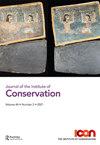简介:Er:YAG激光器在艺术品保护中的应用
IF 1
0 HUMANITIES, MULTIDISCIPLINARY
引用次数: 6
摘要
摘要本文强调了长脉冲Er:YAG激光器在艺术品保护方面的独特性和潜力。从控制、优化和限制材料与激光照射的近表面相互作用的角度总结了激光源和操作参数。当存在时,材料中的O–H键在2940nm(Er:YAG激光器的发射波长)处具有非常强的吸收能力,并且激光脉冲期间的热扩散深度通常较浅,底层材料几乎不受影响。因此,激光照射可以在含有O–H键的介质表面产生有益的热致光破坏,如老化的天然树脂清漆、生物生长和粘合剂。如果不需要的表层缺乏足够的O–H含量,可以用溶剂预先润湿,以增加对激光辐射的吸收。结合溶剂清洁的传统方法描述了不需要的表面材料的激光暴露,并给出了降低底层材料的蚀变和溶解风险的参数。《华尔街日报》这期特刊中的每一篇研究文章的摘要都总结了这一贡献。本文章由计算机程序翻译,如有差异,请以英文原文为准。
Introduction: Er:YAG lasers in the conservation of artworks
Abstract This article highlights the uniqueness and potential of the long pulse Er:YAG laser in the conservation of artworks. Laser sources and operating parameters are summarised in terms of controlling, optimising and confining a material's near-surface interaction with laser irradiation. When present, O–H bonds in materials are very strongly absorbing at 2940nm, the emission wavelength of the Er:YAG laser, and the thermal diffusion depth during the laser pulse is often shallow and underlying material is little affected. Laser exposure can therefore produce beneficial thermally-induced photo-disruption at the surfaces of media that contain O–H bonds, such as aged natural resin varnishes, biological growth and adhesives. If an unwanted superficial layer lacks sufficient O–H content, it can be pre-wetted with solvent to increase absorption of the laser radiation. Laser exposure of unwanted surface material is described in conjunction with conventional methods of solvent cleaning and parameters for reducing the risk of alteration and solubilisation of underlying materials are given. A synopsis of each of the research articles included in this special issue of the Journal concludes this contribution.
求助全文
通过发布文献求助,成功后即可免费获取论文全文。
去求助
来源期刊

Journal of the Institute of Conservation
HUMANITIES, MULTIDISCIPLINARY-
CiteScore
1.50
自引率
0.00%
发文量
22
期刊介绍:
The Journal of the Institute of Conservation is the peer reviewed publication of the Institute of Conservation (Icon). As such, its aims reflect those of Icon, to advance knowledge and education in conservation and achieve the long term preservation and conservation of moveable and immoveable cultural heritage. The Journal provides a collective identity for conservators; it promotes and supports both the profession and professionalism. With international contributions on all aspects of conservation, it is an invaluable resource for the heritage sector. The specific aims of the Journal are to: 1. promote research, knowledge and understanding of cultural heritage conservation through its history, practice and theory 2. provide an international forum to enable and disseminate advances in research, knowledge and understanding relating to conservation and heritage 3. champion and support professional standards of heritage conservation in the UK and internationally 4. provide a permanent record of issues relating to conservation and heritage 5. be financially and operationally sustainable. To achieve these aims, the Journal invites contributions from all those involved in the conservation of cultural heritage and related activities. Areas of interest include understanding cultural heritage materials and their degradation; subject reviews and histories of cultural heritage materials and conservation treatments; new, innovative or improved approaches to conservation and collections care theory, practice, communication, management and training; case studies demonstrating new, innovative or improved approaches; and conservation in its wider context. Submitters are encouraged to demonstrate how their work is of practical application to conservation. To maintain professional standards and promote academic rigour, submissions of articles and shorter notices are subject to an anonymous peer review process.
 求助内容:
求助内容: 应助结果提醒方式:
应助结果提醒方式:


